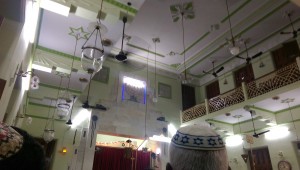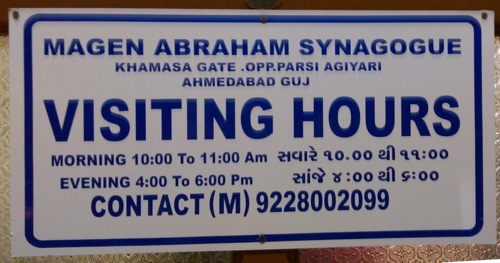Shabbos in Ahmedabad
My wife and I are in Ahmedabad where there was a library conference put on by the Indian Institute of Management. It ended on Friday. We had Saturday plus this morning to see what we could of this very large city.
Friday night was our first day without sleeping pills, and we hardly slept at all — up for the night at 1:30am. Since I was already sick, having caught Ann’s cold, and being a self-pitying weakling, I just wanted to stay in bed and sleep. Which is pretty much what I did for the morning and early afternoon.
At 3pm we set out to walk to the walled city. We figured we’d go to a beautiful Hindu temple there (Swaminaryan Mandir) , and then walk 15 mins to the only Jewish synagogue in the entire region, Magen Abraham.
It is about a 4 mile walk to the Hindu temple, but it took us over three hours because Ahmedabad has blown past the infrastructure for walking. “ Chaotic traffic and people busy with their lives”It is difficult to describe how overwhelming it is. We walked along main roads with sidewalks made impassable by parked motorcycles. We walked through some very poor neighborhoods, where people smiled at us elderly Americans, and called out “Hallo.” Mainly, though, we walked along streets filled with chaotic traffic and people busy with their lives.
And don’t get me started on the traffic. Huge streets with cars, tuktuks, motorcycles, bikes, carts, and anything else that is capable of movement, all without traffic lights Horns replace lanes. The balletics required to make a right turn on a major street with no regulation other than norms and horns are astounding. Crossing a street requires stepping into a lane with the confidence that the oncoming traffic will split around you. Hesitate and you have become a random vector and far more likely to be hit. It is terrifying. Why 40% of the population hasn’t been killed in traffic accidents is one of today’s modern mysteries. “Why 40% of the population of Ahmedabad hasn’t been killed in traffic accidents is one of today’s modern mysteries. ”
Since we couldn’t figure out the algorithm, we went with an heuristic: wait for a local to cross and follow her.
After maybe 2.5 hours, we crossed the Nehru Bridge of the huge river. That side of the river took the other side up a notch. All the way to eleven. More people. More traffic. And an outdoor market that went on for at least a mile, and branched out for acres and acres more on either side. The streets were nearly impassable except by walking in and amongst the crazy traffic.
These are not tourist markets. No geegaws. Just endless shops and carts, crushed together in disregard of every human sense organ.“endless shops and carts, crushed together in disregard of every human sense organ.”
By this time we’d given up on finding the Hindu temple and worked instead on finding the synagogue.
Unfortunately, the street the synagogue is on — Bawa Latif — is unmarked, and apparently unknown by the locals. After many inquiries, all politely responded to, we got into a tuktuk as soon as shabbos was over. The driver pretended he knew where he was going. After more wending through market streets, this time as the bodies with inertia on their side, and after several stops where he asked other drivers where the street was, he dropped us off at the street … except that it was an indoor market, not a street. (I believe that the gate it is immediately next to is Teen Darwaja.) We wandered forlornly looking for a synagogue amongst the stands selling food, clothing, and anything brightly covered.
Ultimately, a Muslim working one of the tables said he knew where the synagogue is, and he walked us to it. We would never ever have found it. Never. Ever. He expressed his commitment to religions respecting one another. We thanked him profusely — I said that helping strangers was so important, and he clasped my shoulders, which was touching in both senses — and we entered the synagogue. “a Muslim working one of the tables said he knew where the synagogue was… ”
It is a place of simple worship. In this, it reminded me of my wife’s synagogue in Boston. I sat silently through the end of sabbath ritual. Afterward, the president of the synagogue chatted us up, and his point of pride was that within a few blocks were five different houses of worship: Jewish, Muslim, Christian, Hindu, and Jain. Even given India’s religious tolerance, nowhere else are the houses of worship that close together, he said.


We took a tuktuk home — the best dollar I ever spent.
The walk this afternoon was difficult, uncertain, and at times — crosswalks! — terrifying. But we will never forget it.









